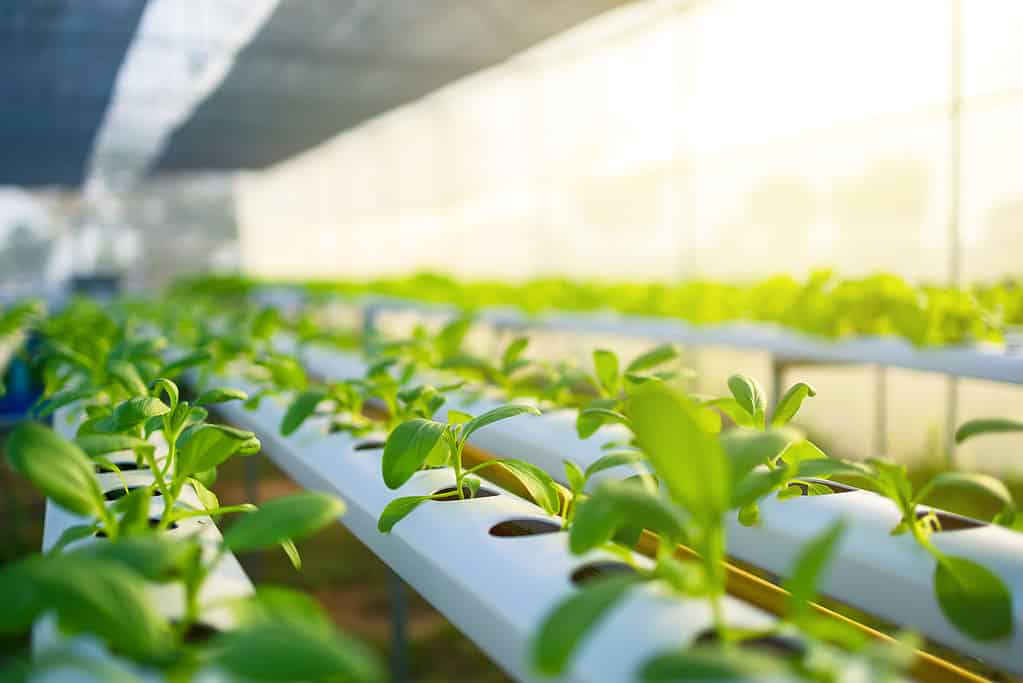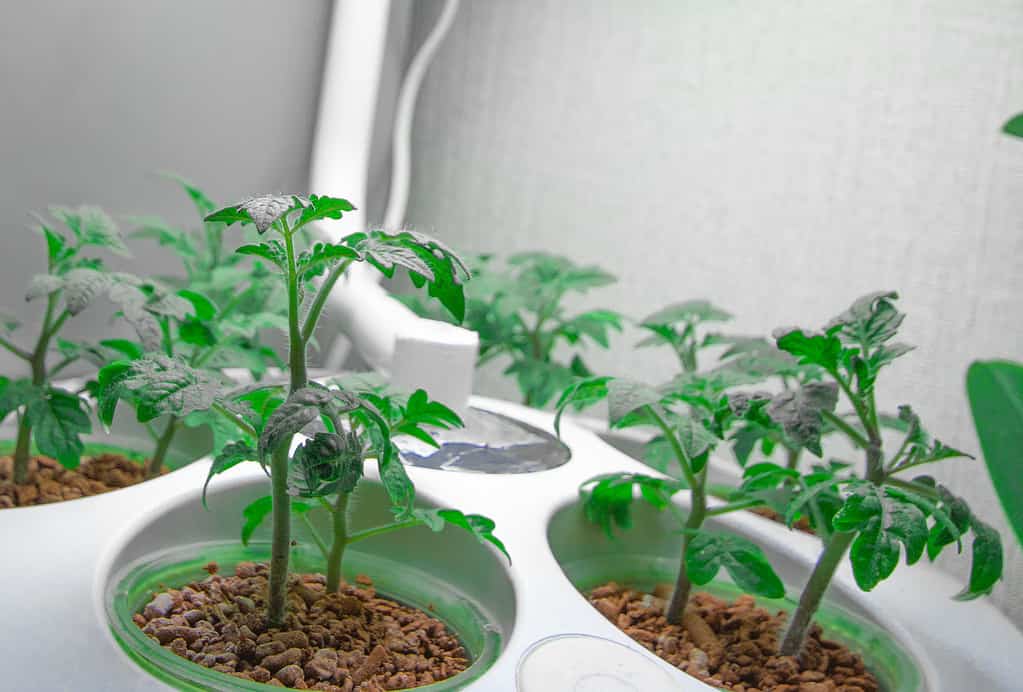Herb lovers, rejoice! There is good news. You can grow your favorite herbs year-round, and you don’t need to rely on pots or window gardens to do so. There is an easier way to get your hands on fresh herbs all year at a fraction of the price of a grocery store. So, how do you grow a hydroponic herb garden? We’ll dive into that below.
What is a Hydroponic Garden?
Standard gardens are what you can find in countless backyards (or front). They get planted in soil and rely on natural sunlight to develop. Hydroponic gardens don’t require soil to grow. Instead, they live in a water-based environment and are typically housed inside.
Hydroponic gardens can be as small as you like (think about a table-top-sized system). Or, they can be the source of commercially grown produce. And every size in between. There are no hard and fast rules governing hydroponic set-ups. However, many have spent countless hours perfecting their system and can give you a head start.
Since hydroponic gardens are versatile and sometimes mobile, you can utilize this growing system regardless of your space limitations (or lack thereof). And one of the best parts is that they even take less water than many people realize! A few other benefits include the ability to grow food all year, even in the coldest climates, and that no weeding is involved.

Hydroponic gardens are often grown inside and rely on water.
©Charnchai/iStock via Getty Images
Purchasing a Hydroponic Garden vs. Building Your Own
Many people swear by their store-bought systems. There is a seemingly endless variety to choose from at different price points. That makes this form of gardening highly accessible to everyone. It may be possible to find pre-boxed systems locally. Or, feel free to order one online. This avenue is ideal for anyone without a lot of extra time on their hands for building projects and those who aren’t keen on DIY projects. The downside is that purchasing a hydroponic garden will cost more.
The potentially more cost-effective route is to build your own. We say potentially because, as with all projects, the final cost will depend on the design and supply cost. Thankfully, the DIY route is also highly versatile. Several online guides and YouTube videos can walk you through the process.
There is no right or wrong way to grow a hydroponic herb garden. Find the method that suits your preferences and lifestyle and dive in!
What Herbs Can Grow in a Hydroponic Garden?
The better question is probably: “What herbs can’t grow hydroponically?” However, some herbs do slightly better in a controlled space than others. Some of the best options for a hydroponic herb garden include dill, rosemary, mint, oregano, thyme, sage, parsley, basil, chives, and watercress.
But don’t feel discouraged if your favorite herbs aren’t on the list. It is by no means exhaustive! Feel free to experiment with a favorite herb. Keep good notes to discover which options work best in your system.
How to Grow a Hydroponic Herb Garden
Growing a hydroponic herb garden is not much different than growing any other plants.
Choose Your System
There are several types of hydroponic systems available. The first step is to choose the one that calls to you or is most appropriate for your needs.
One option is the Deep Water Culture, which is often the most affordable option available. This system includes a deep well for water, which the plants sit on top of. The deep reservoir offers plenty of room for the plant’s roots to grow. A nutrient mixture gets added directly to this water well, which helps feed the plants. Many plants thrive in these conditions. It is also easy to maintain and is ideal for first-time or home gardeners.
Another choice is the Ebb & Flow system. It is an interesting hybrid between traditional soil-based gardening and hydroponics. This system includes a grow bed, where the plants get placed in a growing medium. Below this is a well, where water and nutrients get added. As the name suggests, that water gets pumped into the base of the grow bed intermittently. Many home-based gardeners love the simplicity of this system and its relatively automated nature.
A third option is the drip system. Like the ebb & flow method, drip hydroponics elevates the plants above the water reservoir. It includes a drip irrigation system that feeds nutrient-rich water directly to the roots. You can choose a non-circulating or circulating system, and most are programmable.
Choose a Substrate and Pot
Regardless of the system, all hydroponic options require pots and a substrate. However, this is not the standard option most of us are familiar with. These garden systems require net pots, which give the plants access to water-based nutrition. And the substrate isn’t soil. Instead, many gardeners opt for items like perlite, coconut coir, pumice, or gravel.
Don’t plant any herbs into this substrate without pre-soaking it first. This process will take at least 24 hours. Once that step is complete, dump out the existing water and replace it with a fresh round.

Chosing the right substrate for your hydroponic herb garden is vital.
©Elena Bereberdina/iStock via Getty Images
Purchase a Grow Light
While it isn’t necessary to grow your hydroponic herb garden indoors, that is a common location. Unfortunately, most indoor spaces do not have access to the amount of natural light plants need to survive. That problem is easily remedied. Pick up a grow light (or several) at the local hardware or nursery. Look for one featuring full-spectrum light, which is ideal for herbs.
This step isn’t necessary for any purchased system that comes with a grow light already.

Using grow lights will help your hydroponic herb garden thrive.
©kynny/iStock via Getty Images
Choose Herbs
Now for the fun part, picking herbs to grow! Start with one or several, depending on the size of the hydroponic system and harvesting goals. The beauty of these water-based growing methods is that they make it extremely easy to swap out herb varieties on a whim. Plant the chosen herbs in the appropriate substrate and watch them flourish!
How to Maintain Your Hydroponic Herb Garden
While planting a hydroponic herb garden is relatively quick and easy, maintaining it takes a little extra work. It is vital to stay on top of the feeding schedule. So, find a method to remind yourself when the water-soluble nutrients need to be added. These nutrients will help the herbs grow lush and beautiful, providing a bountiful harvest.
Since stagnant water becomes a hotbed of unwanted bacteria, another critical step is to empty the reservoir and replace it with fresh water. Typically, every two or three weeks is an adequate timetable. However, in between that step, the water may run low. Make a habit of checking the reservoir levels every time the nutrient solution gets added. That will ensure you have the opportunity to top the water level if necessary.
Additionally, most herbs do best in ambient temperatures around 65 to 70 degrees Fahrenheit. Since most standard households tend to sit in that range, it shouldn’t be an issue. But keep an eye on the thermostat just in case.
It is also important to watch for pest infestations and diseases. While they don’t plague herbs grown in hydroponic systems as frequently, these issues still pose a risk. Carefully inspect the herbs regularly, looking for signs of pests like aphids or problems like yellowing leaves. Take rapid steps to address any issues as they arise to ensure the rest of the herbs remain healthy.
Finally, harvest the herbs regularly. Doing so will help the plants grow thicker and more abundantly. And that means an exceptional harvest! Stay on top of trimming back the plants. You can easily preserve whatever portion doesn’t get used in fresh culinary applications.
The photo featured at the top of this post is © kynny/iStock via Getty Images
Thank you for reading! Have some feedback for us? Contact the AZ Animals editorial team.







